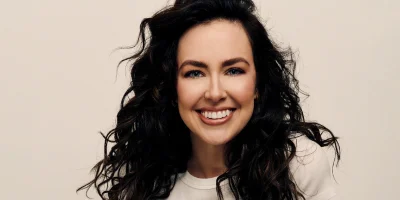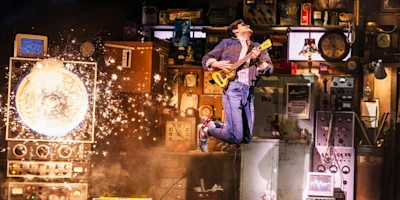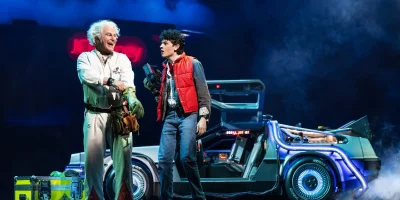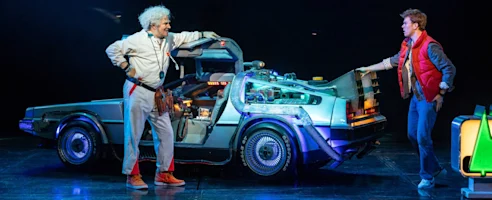
'Back to the Future' review — 1.21 gigawatts of fun, heart, and spectacle
Read our four-star review of Back to the Future on Broadway, the award-winning musical adaptation of the classic film playing at the Winter Garden Theatre.
If IMAX had taken off by 1985, Back to the Future would have been its year's Oppenheimer: the kind of epic film you must see in IMAX, or at least on the biggest screen you can find. The iconic flying DeLorean, piloted across space-time by teenager Marty McFly and scientist Doc Brown, deserves nothing less. Ditto for the stakes of the plot. Unwittingly becoming one of humanity’s first time travelers and nearly wiping out your own existence by meddling in your parents’ meet-cute is, to quote Doc, “some serious shit.”
That's a lot for one teenager like Marty to handle — not to mention the ultimate terror of capturing his unknowing high-school-aged mother’s affections. And yet, Back to the Future emerges, and continues to be regarded, as a funny, cult-classic romp. The musical adaptation, now on Broadway with 1.21 gigawatts of spectacle, honors all these views at once and gives Back to the Future the larger-than-life presentation it deserves.
The design, naturally, does a lot of the heavy lifting. Walking into the Winter Garden Theatre feels like walking into a Back to the Future augmented-reality theme park attraction: A network of LEDs outfits the proscenium, the railings of the box seats, and even the ceiling. The design feels immersive, aided by Finn Ross's videos that, at one point, even put audiences into Marty's point of view as he rockets from 1985 to 1955.
That's not to mention the rest of Hatley's meticulously detailed sets and vibrant period costumes, Tim Lutkin and Hugh Vanstone's hyperactive lighting (which, along with smoke effects, aid Chris Fisher's sci-fi illusions), and Gareth Owen's heart-thumping sound. Together with director John Rando's staging and Chris Bailey's athletic choreography that works the large ensemble for all it's got, the whole production is clearly eager, desperate even, to thrill you at every second. But to again quote Doc (and the title of his triumphant entrance song), it works.
On the topic of the songs, those mostly work, including timeless film favorites like "The Power of Love" and "Johnny B. Goode." A third of the score could have otherwise been cut. Some are repetitive — not every song needs a reprise, and not every character needs a full-length "I want" number (or multiple) where a line or two of dialogue would suffice. It feels like a retroactive attempt to invest audiences in the characters, who get rather abruptly introduced at the start.
It's an odd paradox, that Back to the Future assumes prior familiarity with the film such that the players need little introduction, while positing nearly every character as worthy of substantial exploration. Chalk it up, perhaps, to the fact that two of the movie's creators are involved: Bob Gale adapted the musical's book from his and Robert Zemeckis's screenplay, and Alan Silvestri, who composed the film score, co-wrote the musical's rollicking score with Glen Ballard. They clearly know and adore all their characters, but not all audiences have the same depth of understanding, especially 38 years on from the film's premiere.
But like the DeLorean climbing to the crucial 88 miles per hour, the writers ultimately succeed in building the show's momentum and narrative heft. Once Marty meets his teenaged parents, Lorraine and George, in 1955 and catches Lorraine's eye before George can, he has to course-correct — and gets to know his parents better in the process. Back to the Future is really a story about how the young can shape older generations' futures, after all, not just the other way around.
"My Myopia," a song sung by the hapless George as he secretly watches his future wife from a tree, shows Marty his dad's spinelessness began in adolescence. Later, they share a duet, "Put Your Mind to It," in which Marty teaches George how to be a more confident man. The energetic Casey Likes as Marty and Hugh Coles, a rubber-limbed physical comedy master reprising his role from London, as George bring these scenes close to perfect. As Lorraine, Liana Hunt channels a Grease-era Olivia Newtown John in dulcet (if incestuous) songs like "Pretty Baby."
It could be easy, amid everything else going on, to minimize Doc, even though he invents time travel in the first place and makes the rest of Back to the Future possible. But Christopher Lloyd made the character so indelible on screen that to forget Doc would be a crime. And from his first entrance in a cloud of smoke, Roger Bart, also reprising his role from London, makes the character iconic anew.
Bart milks Doc's triumphant early songs for all they're worth, complete with a leggy ensemble as backup — which only make his poignant Act 2 ballad, "For the Dreamers," strike the heartstrings even more. It's then we learn that, before Marty proved otherwise, Doc spent 30 years worrying he'd fail — and be forgotten in time.
"This one's for the dreamers who were close, but no cigar," Doc laments, Bart utterly sincere. "We don't know who they are."
Back to the Future is many in-your-face things — larger-than-life, time-bending, hair-raising — but this small moment reveals the heart amid the spectacle.
Photo credit: Casey Likes and the cast of Back to the Future. (Photo by Matthew Murphy and Evan Zimmerman)
Correction: A previous version of this article misstated the number of years since the Back to the Future film's premiere. The article has been updated to reflect the correct information.
Frequently asked questions
What is Back to the Future about?
Great Scott, the classic time-traveling movie is now a Broadway musical. Join Marty McFly's plutonium-powered adventure from 1985 to 1955, where he almost prevents his parents from meeting and has to make things right. The stage version features new songs alongside the film's hits, like "The Power of Love." Find out more about tickets.
Where is Back to the Future playing?
Back to the Future is playing at Winter Garden Theatre. The theatre is located at 1634 Broadway (between 50th and 51st Street), New York, 10019.
How long is Back to the Future?
The running time of Back to the Future is 2hr 35min. Incl. 15min intermission.
What's the age requirement for Back to the Future?
The recommended age for Back to the Future is Ages 6+. Children under 4 are not permitted..
How do you book tickets for Back to the Future?
Book tickets for Back to the Future on New York Theatre Guide.
Is Back to the Future: The Musical based on the movie?
Back to the Future: The Musical is based on the movie. The stage show has the same plot and characters, but the musical adds more original songs alongside the film's most famous tunes.
Who wrote Back to the Future: The Musical?
Bob Gale, a co-writer of the original film's script, wrote the script for Back to the Future: The Musical. Alan Silvestri and Glen Ballard wrote the music and lyrics; Silvestri previously composed the film's score.
Are the songs from the Back to the Future movie in the musical?
Yes, "The Power of Love," "Johnny B. Goode," and "Earth Angel" all appear in Back to the Future on Broadway. The rest of the musical's score consists of new, original songs by Alan Silvestri and Glen Ballard.
Who plays Doc Brown in Back to the Future: The Musical?
Roger Bart plays Doc Brown in Back to the Future: The Musical, reprising the role from the world-premiere production in London. He's best known for You're a Good Man, Charlie Brown, for which he won the Tony Award for Best Featured Actor in a Musical.
Who plays Marty McFly in Back to the Future: The Musical?
Casey Likes plays Marty McFly in Back to the Future on Broadway. He's also known for playing William Miller in the Broadway adaptation of Almost Famous and Gene Simmons in the film Spinning Gold.
Is Back to the Future: The Musical appropriate for kids?
Back to the Future: The Musical is recommended for kids age 6 and up. The show contains some brief sexual themes, but the content is otherwise appropriate for children. Please note that children 4 and younger are not permitted in Broadway theatres.
Who directed Back to the Future: The Musical?
John Rando directs Back to the Future on Broadway. He is a Tony Award winner for staging Urinetown and a nominee for On the Town. He's also known for directing shows like The Wedding Singer and Mr. Saturday Night, also adapted from popular films.
Is Back to the Future on Broadway good?
New York Theatre Guide's four-star review reads, "The musical adaptation, now on Broadway with 1.21 gigawatts of spectacle... gives Back to the Future the larger-than-life presentation it deserves. The show is a great option for fans of the movie and anyone looking for an energetic show with impressive design and special effects.
Originally published on




